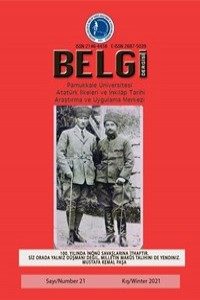Abstract
Kurtuluş Savaşı’ndan sonra gerçekleşen inkılâp hareketlerinin ortak amacı, Türk toplumunu her alanda çağdaş ve akılcı bir yöntemle modern bir toplum haline getirmekti. Bu amaçla 19 Şubat 1932 tarihinde “kültür kurumu” olarak adlandırılan halkevleri açıldı. 1932-1951 döneminde halkevleri; güzel sanatlar, temsil, dil ve edebiyat, spor, sosyal yardım, halk dershaneleri ve kurslar, kütüphane ve yayın, köycülük ile tarih ve müze şubesi olmak üzere toplam 9 şube ve bu şubelere bağlı birçok kol aracılığıyla faaliyet gösterdi. Güzel sanatlar şubesinin amacı; müzik, resim, heykel, mimari ve süsleme sanatları alanında amatör ve profesyonel unsurları bir araya toplamak, genç kabiliyetleri korumak ve bunların yetişmelerini sağlamaktı. Temsil şubesinin amacı da temsil sanatına istekli ve kabiliyetli üyelerden oluşan bir temsil grubu oluşturmaktı.
İstanbul halkevlerinin güzel sanatlar şubeleri müzik faaliyetleri içinde daha çok Türk müziğine yönelik koro faaliyetleri ve konserler üzerinde durmaktaydı. Eminönü, Kadıköy, Şişli ve Beyoğlu halkevlerinin kendilerine ait orkestraları vardı. Sergi faaliyetleri resim ve fotoğraf ağırlıklı olup ülkenin ilk “diyaroma sergisi” nin açılışı bu dönemde Eminönü Halkevi tarafından yapıldı. Temsil şubelerinin faaliyetleri de piyes, bale, opera, revü, kanto, kukla-karagöz, meddah, hokkabaz, orta oyunu, sinema ve film gösterilerinden oluşmaktaydı.
İstanbul’da 1932-1935 tarihleri arasında sadece İstanbul Halkevi faaliyet gösterdi ve 1935 yılında yeniden yapılandırmaya gidilerek halkevinin faaliyetlerine son verildi. Aynı yıl İstanbul’da Eminönü, Şehremini, Beyoğlu, Beşiktaş, Kadıköy, Üsküdar ve Şişli halkevleri açıldı. Bu halkevlerini 1938 yılında Fatih, Bakırköy ve Eyüp halkevleri, 1939 yılında Şile, 1940’da Sarıyer halkevlerinin açılması izledi. 1945 yılında Kartal, Yalova ve 1946 yılında da Çatalca, Beykoz ve Yeşilköy halkodaları halkevlerine dönüştürüldü.
Bu çalışmada 1939-1951 döneminde İstanbul’da faaliyet gösteren 17 halkevine bağlı güzel sanatlar ve temsil şubelerinin faaliyetleri; “müzik, sergi ve temsil” alt başlıkları altında incelendi.
Keywords
İSTANBUL HALKEVLERİ GÜZEL SANATLAR ŞUBESİ TEMSİL ŞUBESİ İSTANBUL HALKEVLERİ MÜZİK FAALİYETLERİ İSTANBUL HALKEVLERİ SERGİ FAALİYETLERİ İSTANBUL HALKEVLERİ TEMSİL FAALİYETLERİ
References
- Cumhuriyet Arşivi Belgeleri (BCA), Cumhuriyet gazetesi, Akşam Gazetesi, Tan Gazetesi, Yeni Türk Dergisi, İstanbul Halkevleri Dergisi, CHP Halkevleri 1940 (1941), CHP Halkevleri Talimatnamesi (1932), CHP 1939’da Halkevleri (1939),CHP Halkevleri ve Halkodaları, CHP Halkevleri ve Halkodaları (1948), Dranas, Muhip (1941), Halkevleri Sergileri, Halkevleri Çalışma Talimatnamesi (1940), Halkevleri ve Halkodaları 1932-1942 (1942), Halkevleri İdare Teşkilat Talimatnamesi (1940), Halkevleri Öğreneği (1935), Halkevleri Tiyatro Repertuvarı (1939),.
Abstract
The common aim of the revolution movements that took place after the War of Independence was to turn Turkish society into a modern society with a modern and rational method in every field. For this purpose, public houses called "cultural institutions" were opened on February 19, 1932. People's Houses of the 1932-1951 Period; It has operated through a total of 9 branches, including fine arts, representation, language and literature, sports, social aid, public courses and courses, library and publishing, peasant and history and museum branches, and many branches affiliated with these branches. The purpose of the fine arts branch; to gather amateur and professional people in the fields of music, painting, sculpture, architecture and decorative arts, to protect and educate young talents. The aim of the representative branch was to create a representative group consisting of members who were willing and talented in the art of representation.
Fine arts branches of Istanbul community centers mostly focused on choral activities and concerts for Turkish music in musical activities. Eminönü, Kadıköy, Şişli and Beyoğlu community centers had their own orchestras. Exhibition activities were mainly painting and photography and the opening of the first "diorama exhibition" of the country was held by Eminönü Community Center during this period. The activities of representation branches consisted of play, ballet, opera, revue, canto, puppet-karagöz, meddah, juggler, middle play, cinema and film shows.
Between 1932 and 1935, only the Istanbul People's House operated in Istanbul, and in 1935, the activities of the community center were ended by restructuring. In the same year, Eminönü, Şehremini, Beyoğlu, Beşiktaş, Kadıköy, Üsküdar and Şişli community centers were opened in Istanbul. These were followed by the opening of the Fatih, Bakırköy and Eyüp community centers in 1938, the Şile in 1939 and the Sarıyer community centers in 1940. In 1945, Kartal, Yalova and in 1946 Çatalca, Beykoz and Yeşilköy public halls were turned into community centers.
In this study, the activities of the fine arts and representation branches of 17 community centers operating in Istanbul during the 1939-1951 period were examined under the sub-headings of music, exhibition and representation.
Keywords
ISTANBUL COMMUNITY CENTERS FINE ARTS BRANCH REPRESENTATION BRANCH ISTANBUL COMMUNITY HOUSES MUSİC ACTIVITIES ISTANBUL COMMUNITY HOUSES REPRESENTATION ACTIVITIES ISTANBUL COMMUNITY EXHIBITION ACTIVITIES
References
- Cumhuriyet Arşivi Belgeleri (BCA), Cumhuriyet gazetesi, Akşam Gazetesi, Tan Gazetesi, Yeni Türk Dergisi, İstanbul Halkevleri Dergisi, CHP Halkevleri 1940 (1941), CHP Halkevleri Talimatnamesi (1932), CHP 1939’da Halkevleri (1939),CHP Halkevleri ve Halkodaları, CHP Halkevleri ve Halkodaları (1948), Dranas, Muhip (1941), Halkevleri Sergileri, Halkevleri Çalışma Talimatnamesi (1940), Halkevleri ve Halkodaları 1932-1942 (1942), Halkevleri İdare Teşkilat Talimatnamesi (1940), Halkevleri Öğreneği (1935), Halkevleri Tiyatro Repertuvarı (1939),.
Details
| Primary Language | Turkish |
|---|---|
| Journal Section | Research Article |
| Authors | |
| Publication Date | January 1, 2021 |
| Submission Date | November 21, 2020 |
| Acceptance Date | December 11, 2020 |
| Published in Issue | Year 2021 Issue: 21 |


